What Are Acceptance Criteria for a User Story?
In a user story, acceptance criteria are specific conditions that must be met for the story to be considered complete and successful. They define the scope, functionality, and quality requirements to ensure that the development team understands what they need to do for the final product to meet stakeholder expectations.
Usually, acceptance criteria appear on tickets submitted to the development team by product owners, Scrum Masters, project managers, or other stakeholders. The ticket will refer to a specific task or user story.

“When the ticket submitter outlines the acceptance criteria, it’s usually a list of specific results, and once you meet those results, you’ve completed the task,” explains Hugh Smith, a software engineer with more than a decade of experience working in Agile environments. “From a software engineer’s perspective, the acceptance criteria is almost a protection against whoever submits the ticket. It’s the protection against a constant back and forth where you think you’ve done what they told you to do, but the result doesn’t quite line up with their expectations.”
User Story vs. Acceptance Criteria
A user story is a short, simple description of a feature or requirement from the perspective of the end user. It details what the user needs and why. Acceptance criteria — also called user acceptance criteria (UAC) — are detailed conditions that specify when a user story is considered complete.
For more information on user stories, read our guides on writing user stories for software development and how to do effective user story mapping.
Rule-Oriented vs. Scenario-Oriented Acceptance Criteria
Rule-oriented acceptance criteria focus on specific rules or conditions that must always be met for the user story to be considered complete. Scenario-oriented acceptance criteria describe specific situations or use cases that demonstrate how the system should behave under certain conditions.
Scenario-oriented acceptance criteria work best for user stories that involve user interactions or end-to-end workflows. This is because they illustrate the specific steps a user will take and are meant to ensure that the feature works as intended.
In contrast, rule-oriented acceptance criteria are ideal for stories focused on validation, compliance, or technical requirements, as they define the specific conditions or rules that must be met. This approach ensures that you verify and validate both functional and nonfunctional aspects of a feature.
How to Write Acceptance Criteria
To write acceptance criteria, start with the user story. Describe what a person can do with the product. Next, consider the technical requirements (how the product provides that functionality). Finally, write the acceptance criteria (how to fulfill these requirements).
For rule-oriented acceptance criteria, focus on defining specific, consistent rules or conditions that must always be met. For scenario-oriented acceptance criteria, describe specific use cases or situations that demonstrate how the system should behave under particular conditions.
Berthot suggests following the given-when-then format for these acceptance criteria: “Given [function input or data] when [operational functionality trigger], then [criteria to achieve desired goal].”
Remember, both rule-oriented and scenario-oriented acceptance criteria should always be clear and specific, measurable, and testable.
“I would expect the writer of the ticket to give me full input and tell me what the full output should be,” says Smith.

“A user story is not very useful unless it can be tested by the team, which is why acceptance criteria are added to give the team one or more use cases that allow the team to understand how the story may be tested,” explains Bryan Berthot, Scrum Master, Project Manager, and doctoral candidate at the University of South Florida.
Learn how to write user-centric acceptance criteria, and check out one of these free user story templates to get started.
Examples of User Stories with Acceptance Criteria by Type
Examples of acceptance criteria types include scenario-oriented and rule-oriented, as well as criteria for testing system behavior. The following examples will guide you in crafting precise and effective acceptance criteria.
Additionally, we’ve gathered examples to help you fix unclear or incomplete criteria. Use these to ensure your user stories are comprehensive and aligned with your project’s goals.
Check out our guide of more than 100 user story examples before you dive into defining acceptance criteria.
Basic Acceptance Criteria Examples
These basic examples of acceptance criteria show how a few simple sentences can effectively ensure that features meet their intended functionality, making it easier for teams to verify and validate outcomes.
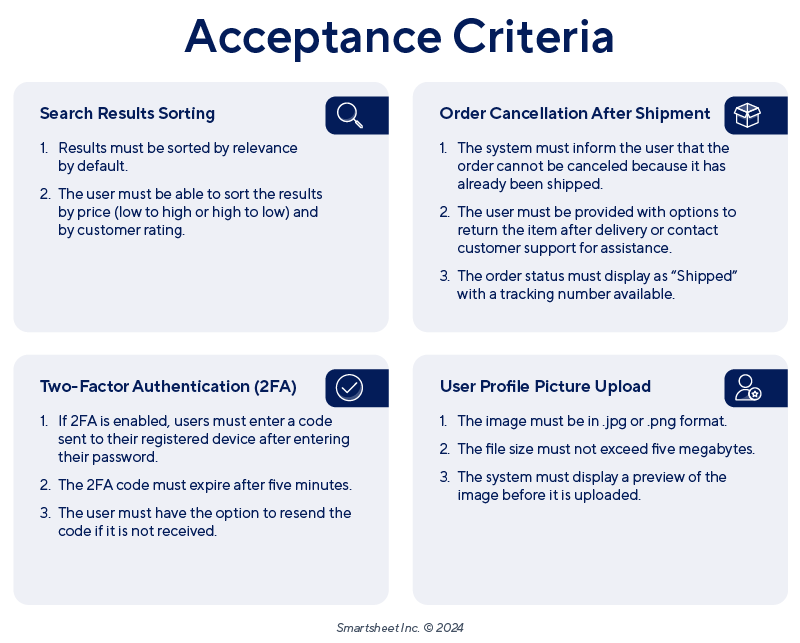
Example User Stories with Acceptance Criteria
These example user stories have clear, actionable acceptance criteria that ensure precise functionality, making them valuable guides for a development team.
| User Story | Acceptance Criteria |
|---|---|
| As a content creator, I want to schedule my posts in advance so that I can maintain a consistent publishing schedule. |
|
| As a student, I want to download course materials so that I can study offline. |
|
| As an online customer, I want to view my purchase history so that I can keep track of my orders. |
|
Given-When-Then Acceptance Criteria Examples
The following examples of scenario-oriented acceptance criteria, provided by project management expert Bryan Berthot, follow the given-when-then format, which clearly defines the conditions, actions, and expected outcomes for each user story.
Managing Contacts Within an Application
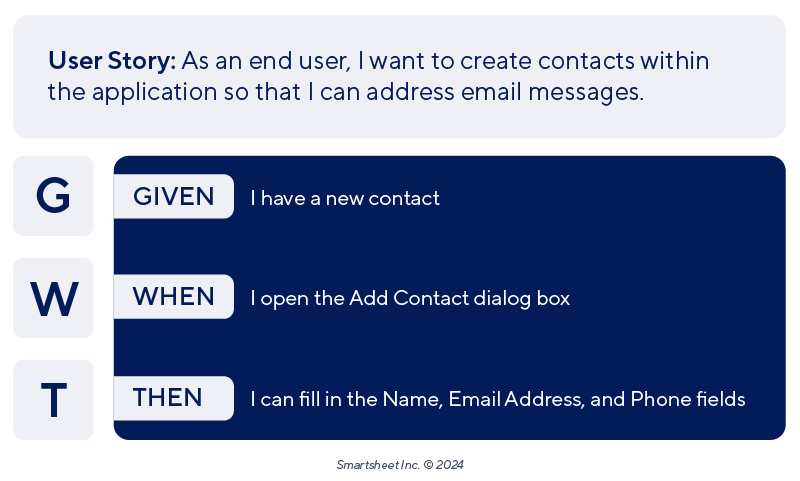
Concrete Porch Behind the House

Acceptance Criteria Examples for Testing System Behavior
The following examples of rule-oriented acceptance criteria show lists of conditions or requirements that must be met — regardless of specific user scenarios — and can be used to test overall system behavior.
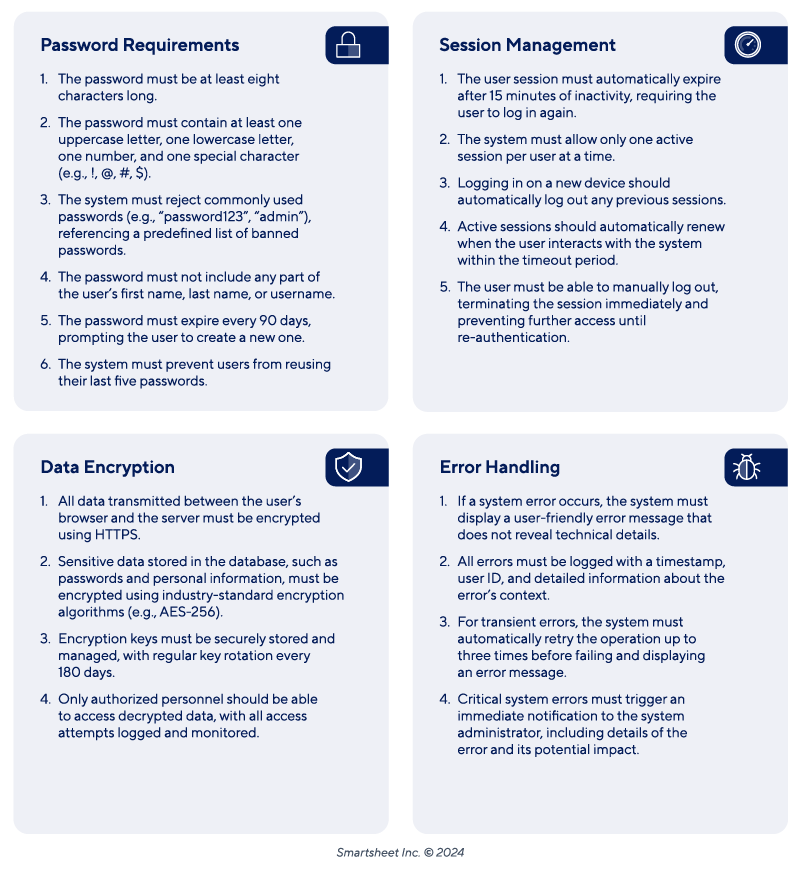
Example of an Epic with Acceptance Criteria
The following example epic is first broken down into smaller, more manageable user stories. Then you can add specific acceptance criteria that define how each story should be implemented and validated.
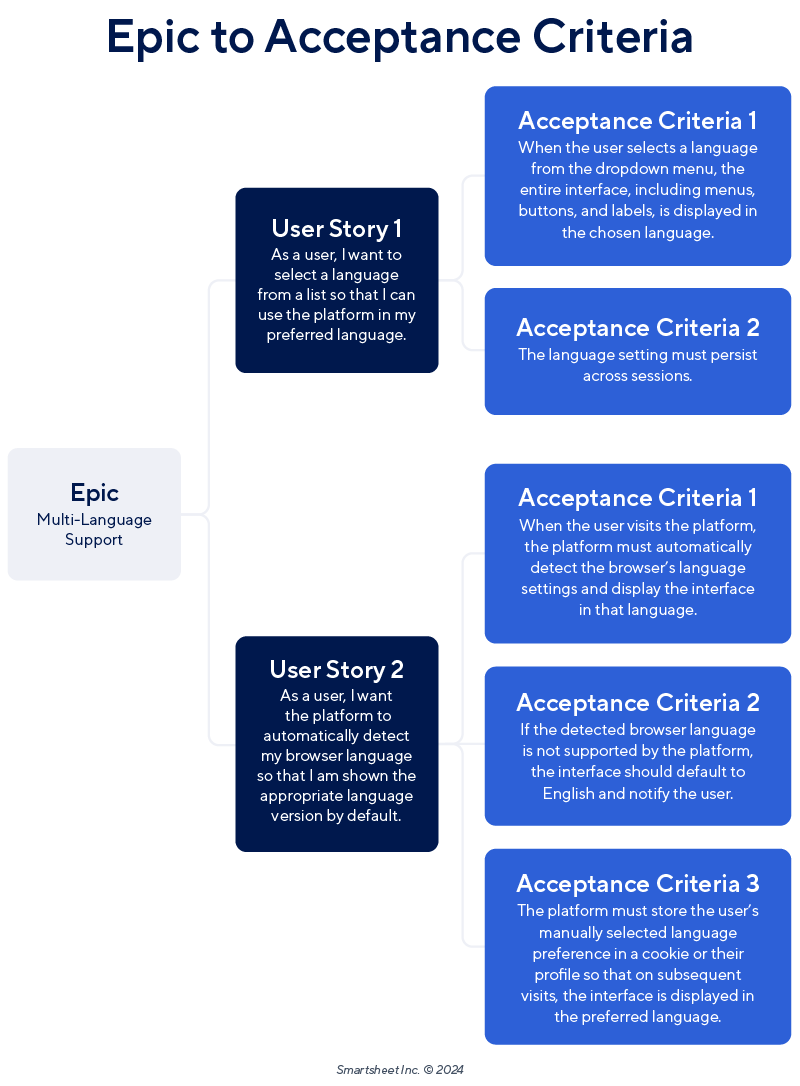
Bad Acceptance Criteria Examples
First and foremost, acceptance criteria should help the code developers by telling them exactly what the outcome of their work should look like or achieve. Acceptance criteria that are ambiguous, overly detailed, or contradictory will not be helpful to the developer and can lead to confusion, delays, or incorrect implementations.
Here are several examples of bad acceptance criteria and how to fix them:
Examples of Bad Acceptance Criteria (and How to Fix Them)
| Problem | Example | Why It Doesn’t Work | How to Fix It |
|---|---|---|---|
| Vague or Ambiguous Language | The page should load quickly and be user-friendly. | This criterion is subjective and lacks specificity. What constitutes “quickly”? What defines “user-friendly”? Developers might interpret these terms differently, which will lead to inconsistent results. “When acceptance criteria are vague, it can end up wasting time and effort because I might have written a bunch of code that doesn’t actually solve the problem that needs solving and will have to get thrown out,” says Smith. | Define specific, measurable criteria for “quickly” and “user-friendly” that can be tested objectively. |
| Overly Detailed and Prescriptive | The database should be implemented using a specific NoSQL database and use a document-based storage system. | This criterion dictates how the solution should be implemented rather than what it should achieve. This limits the developer’s flexibility to choose the most appropriate technology based on the overall system requirements. “If the requestor is nitpicking, they’ll get a negative outcome because they don’t have the same expertise as the actual software engineers,” says Smith. | Focus on the desired outcome rather than prescribing a specific technology or approach. |
| Contradictory Criteria | The button should be green and stand out. The button should blend in with the overall page design. | These criteria conflict with each other. It’s unclear how a button can both “stand out” and “blend in.” This example would leave the developer unsure which priority to focus on. “Usually, if I notice there are contradictory criteria, I end up sending the tickets back,” says Smith. “A lot of times, though, you don’t realize there’s contradictory stuff until later in the process, which can waste time.” | Clarify the primary goal and provide criteria that do not conflict with each other. |
Examples of User Stories with Acceptance Criteria by Use Case
The following examples of user stories with acceptance criteria are tailored to specific use cases, such as banking transactions, Scrum, Agile processes, CRM systems, APIs, and more.
Agile User Story with Acceptance Criteria Examples
These examples illustrate how well-crafted user stories and acceptance criteria can ensure that you define tasks clearly, processes run smoothly, and team members know exactly what’s expected to keep an Agile project on track.
| User Story | Acceptance Criteria |
|---|---|
| As a developer, I want to merge my code changes into the main branch so that the team’s work is integrated. |
|
| As a project manager, I want to assign tasks to team members so that work is distributed efficiently. |
|
| As a tester, I want to log bugs found during testing so that they can be tracked and resolved. |
|
Scrum User Story with Acceptance Criteria Examples
These Scrum examples demonstrate how precise user stories and acceptance criteria help streamline sprint tasks, facilitate team collaboration, and ensure that project goals are met.
| User Story | Acceptance Criteria |
|---|---|
| As a Scrum Master, I want to create and manage the sprint backlog so that the team can stay organized and focused on sprint goals. |
|
| As a product owner, I want to prioritize the product backlog so that the most valuable features are developed first. |
|
API Development Acceptance Criteria Example
Acceptance criteria help ensure that the endpoints of an application programming interface (API) meet specified requirements and handle requests and responses accurately. The criteria should provide clear guidelines for developers to follow.

Sidharth Ramsinghaney, Director of Strategy and Operations at Twilio, provides hypothetical examples of acceptance criteria for a short message service (SMS) API:
User Story: As a developer, I want to integrate SMS API into my application so that I can send automated text messages to users for notifications.
Acceptance Criteria:
- The API integration should allow sending SMS to any valid phone number.
- The system should log each sent message with a timestamp and status.
- The integration should handle errors gracefully and provide meaningful error messages.
These acceptance criteria are clear, testable, and directly aligned with the goal of the user story. By focusing on essential functionality, how to handle errors, and measurable outcomes, they provide a strong foundation for successful implementation.
CRM User Story with Acceptance Criteria Example
Acceptance criteria in CRM development help ensure that features are implemented correctly and integrate smoothly with existing systems.
Ramsinghaney also provides an example of a user story with acceptance criteria for a CMS:
User Story: As a customer support agent, I want to use voice API to make outbound calls directly from our CRM system so that I can efficiently manage customer interactions.
Acceptance Criteria:
- The CRM system should have a Call button that initiates an outbound call using Twilio’s voice API.
- The call should be logged in the CRM with details such as call duration and outcome.
- The system should support call recording and playback within the CRM.
These acceptance criteria outline clear, actionable tasks, such as how to initiate, log, and record a call.
Examples of User Stories with Acceptance Criteria for Bank Transactions
When creating or improving bank transaction systems, acceptance criteria are essential for defining secure, accurate, and compliant processes.
| User Story | Acceptance Criteria |
|---|---|
| As a customer, I want to transfer money between my accounts so that I can manage my finances easily. |
|
| As a customer, I want to schedule recurring payments so that I can automate my bill payments. |
|
Examples of User Stories with Acceptance Criteria for Project Management Software
When creating or improving project management software, acceptance criteria provide clear expectations for developers so they can create functionality that supports seamless team collaboration and project flow.
| User Story | Acceptance Criteria |
|---|---|
| As a team member, I want to log my work hours on tasks so that I can track and bill for my time accurately. |
|
| As a project manager, I want to set project milestones so that I can track major deadlines. |
|
Downloadable PDF User Story Examples with Acceptance Criteria
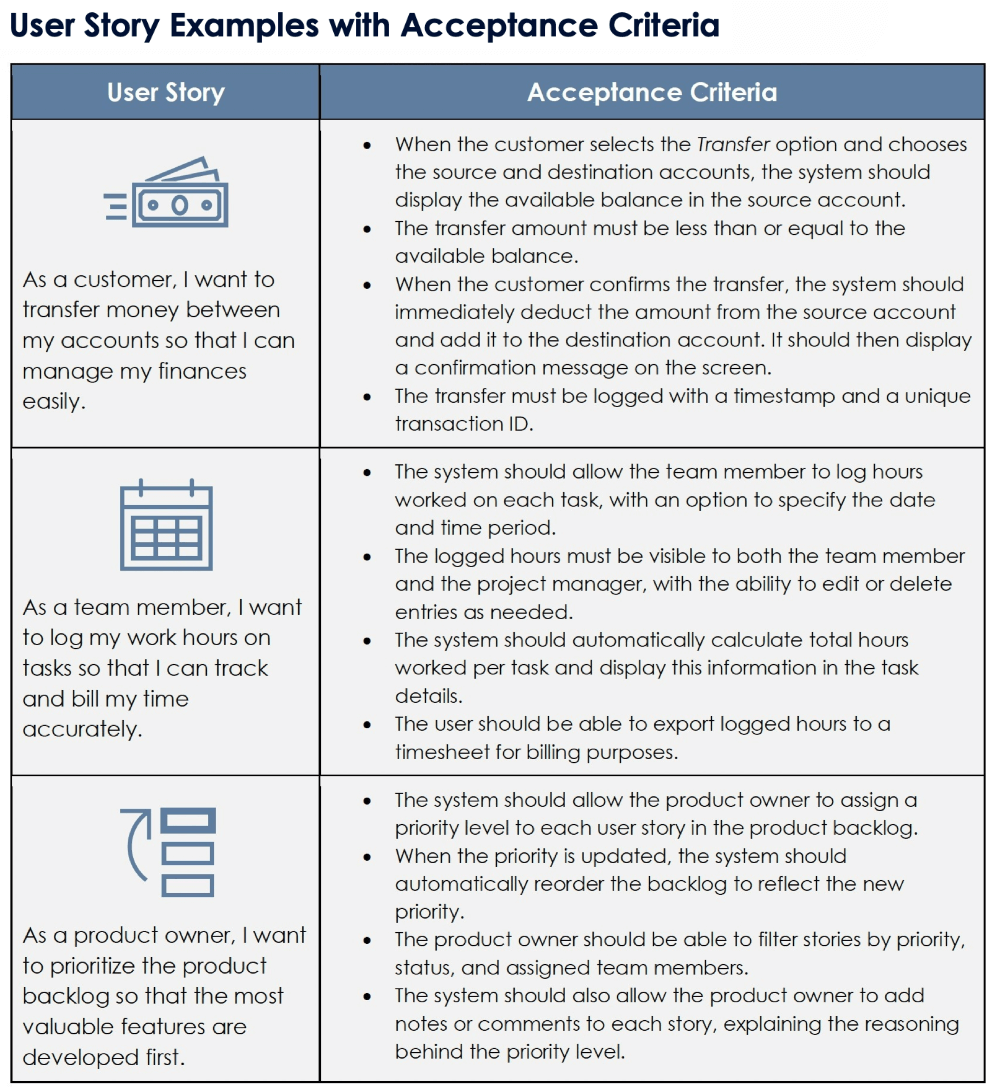
Download User Story Examples with Acceptance Criteria for Adobe PDF
For a printable roundup of three examples from this article, download this one-page list of sample user stories and their acceptance criteria. Reference this list whenever you need a quick refresher on what acceptance criteria should look like.
Effectively Define and Track User Stories with Smartsheet for Project Management
From simple task management and project planning to complex resource and portfolio management, Smartsheet helps you improve collaboration and increase work velocity -- empowering you to get more done.
The Smartsheet platform makes it easy to plan, capture, manage, and report on work from anywhere, helping your team be more effective and get more done. Report on key metrics and get real-time visibility into work as it happens with roll-up reports, dashboards, and automated workflows built to keep your team connected and informed.
When teams have clarity into the work getting done, there’s no telling how much more they can accomplish in the same amount of time. Try Smartsheet for free, today.